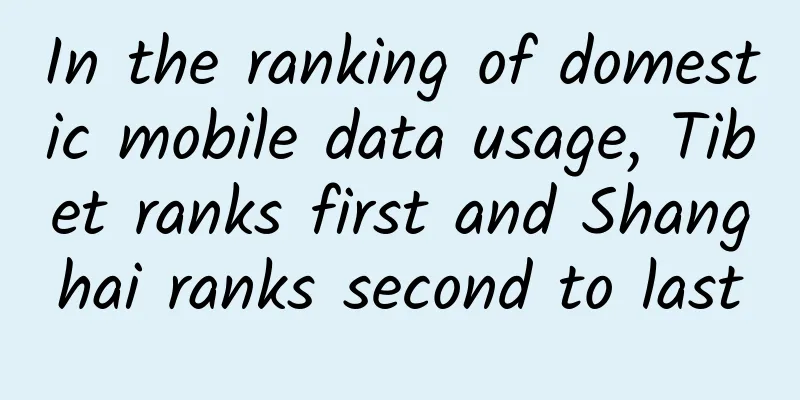In the ranking of domestic mobile data usage, Tibet ranks first and Shanghai ranks second to last

|
Recently, the Ministry of Industry and Information Technology released the "Economic Operation Status of the Communications Industry from January to August 2021", which mentioned a lot of content, which will not be elaborated here one by one.
This time, we want to find out an answer, that is: How much data usage do mobile phone users have in various provinces and cities in China? Which province has the most powerful mobile phone data usage, and which province has the "weakest"? Many people think that mobile phone users in first-tier cities and developed provinces use more data. In fact, the result is just the opposite. In a press release on China News Network in May 2019, it was written: "Since September 2017, Qinghai Province has ranked first in the country in mobile Internet access traffic for 19 consecutive months. In the first quarter of this year, the average traffic per mobile Internet access user in Qinghai Province exceeded 10GB. A large number of mobile phone users use about 30GB per person per month." However, Tibet came from behind. Since the Ministry of Industry and Information Technology began disclosing mobile Internet access traffic in various regions in May 2020, Tibet has consistently ranked first. In May 2020, the mobile Internet access traffic (DOU) of Tibetan users was 16.1GB/household, ranking first; Guizhou was 15.05GB/household, ranking second; Yunnan was 14.66GB/household, ranking third. Then came Qinghai, Ningxia, and Xinjiang. In other words, the top six are all western provinces. Shanghai ranked second from the bottom, Beijing ranked ninth from the bottom, and Heilongjiang ranked last (6.69GB/household). The average monthly traffic usage of Tibetan users is about 9GB more than that of Heilongjiang and Shanghai users. As time goes by, the gap has not narrowed but widened. For the sake of convenience, we selected the data from July 2021. The Ministry of Industry and Information Technology disclosed that in July 2021, the DOU values of Tibet, Qinghai, Yunnan and Xinjiang exceeded 18GB/household that month, ranking the top four. Guizhou ranked fifth. This is the same as the situation more than a year ago. Tibet (22.8GB/household) and Qinghai still firmly occupy the top two positions, and the top five are still western provinces. Shanghai still ranks second from the bottom. According to data released by the Shanghai Communications Administration, the average mobile Internet access traffic (DOU) per household in Shanghai was 10.3GB/household in July 2021. In other words, the average monthly traffic used by Shanghai users is 12.5GB less than that of Tibetan users, or the traffic usage level of Shanghai users is less than half of that of Tibetan users. Why does this happen?Personally, I think that, on the one hand, this is closely related to the development level of wired broadband and indoor WiFi networks. According to the results of the seventh national census, Tibet has a permanent population of 3.6481 million, of which 1.3034 million are urban residents and 2.3447 million are rural residents. According to data from the Tibet Communications Administration, in July 2021, there were 1,078,700 fixed Internet broadband access users in Tibet, including 744,100 urban broadband access users and 333,600 rural broadband access users. According to calculations, fixed-line broadband users account for 29.6% of the total population in Tibet, and there is a huge gap between urban and rural areas. Fixed-line broadband users account for 57% in urban areas and 14.3% in rural areas. Let's look at Shanghai, which has a permanent population of 24.87 million. At the end of July 2021, Shanghai had 9.62 million fixed Internet broadband access users. Calculated, fixed-line broadband users account for 38% of the city's permanent population. Overall, the level of fixed Internet penetration in Shanghai is higher, and with the development of whole-house WiFi, the quality of WiFi wireless networks in users' homes is also rapidly improving. Both units and homes have access to WiFi networks, which will naturally have a diversion effect on mobile Internet traffic. In addition, western provinces, municipalities and autonomous regions such as Tibet are generally sparsely populated, and the development of wired broadband in urban and rural areas varies greatly, especially in rural areas, where mobile Internet traffic usage is naturally higher. On the other hand, this is related to the significant decline in traffic charges brought about by the continued implementation of the policy of speed increase and fee reduction. In recent years, the unit price of traffic has declined rapidly, from 35 yuan/GB in 2017 to 5 yuan/GB in 2019, and then to 4.4 yuan/GB in 2020. For users, as the unit price of traffic continues to decline, they are more and more "daring" to use traffic, and they are more and more daring to use it. Large amounts of traffic can meet the Internet needs of many people. |
>>: Pairing private networks with 5G to boost smart city development
Recommend
Kubernetes uses OkHttp client for network load balancing
During an internal Java service audit, we discove...
Master the knowledge of optical modules in one article and become a necessary skill for network engineers
In this era of information explosion, data transm...
Why can Wi-Fi 6 be used by multiple people without being crowded? Intel's popular science is here
At the end of 2018, the Wi-Fi Alliance announced ...
Detailed explanation of the three most commonly used wiring systems in integrated wiring!
The integrated wiring system is the infrastructur...
3 Types of Wireless Network Site Surveys and How to Perform Them
Designing and maintaining a network is complex, b...
Ten Tips to Simplify Fiber Optic Cable Installation
Installing fiber optic cable is a complex and tim...
What does the arrival of 5G mean for the Internet of Things?
In today’s fast-paced, hyper-connected and tech-e...
10gbiz: Hong Kong/Los Angeles VPS 60% off from $2.76/month, CN2 GIA line, Hong Kong dedicated server first month from $36.57
I received an October promotion from 10gbiz, offe...
Tudcloud: Hong Kong VPS with 20% off for monthly payment and 30% off for half-year payment, with options of large bandwidth or unlimited traffic
Tudcloud has released a year-end discount, offeri...
The first Global Cybersecurity Industry Innovation Forum opens in Shanghai
On November 7, 2017, the first "Global Cyber...
In the Internet Queen’s “Spring Festival Gala-style report”, what are the things worth spending five minutes paying attention to?
Internet Queen Mary Meeker's annual Internet ...
How Fiber Optic Networks Can Boost Small Business Operations
What is Fiber Optic? This is a form of internet t...
Analysis of Python's new string format vulnerability
Preface This article conducts an in-depth analysi...
What is the global development situation of IPv6?
Statistics from authoritative foreign organizatio...
Linkerd 2.10 (Step by Step)—Ingress Traffic
[[406692]] The Linkerd 2.10 Chinese manual is bei...
![[6.18] UFOVPS 20% off, top up 200 yuan and get 10 yuan, US CN2/Japan CN2 GIA/Hong Kong CN2 GIA optional](/upload/images/67cabe6b63f72.webp)

![[Black Friday] SpartanHost Dallas VPS 50% off, optional AMD or E5 series, 10Gbps bandwidth, high-security VPS](/upload/images/67cabccb63bd4.webp)






